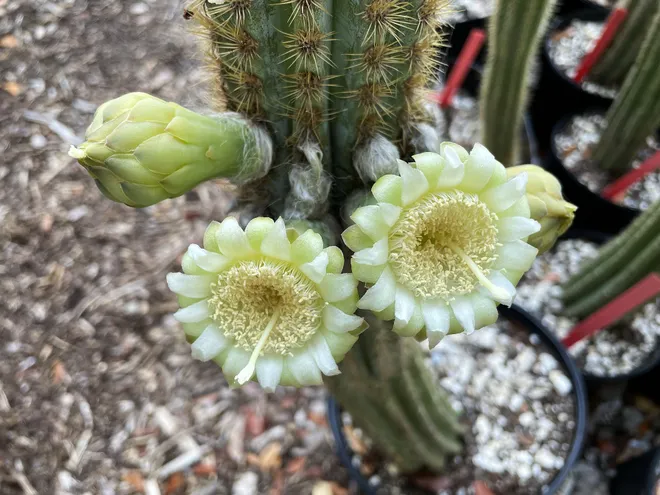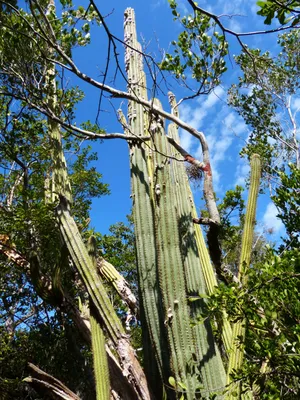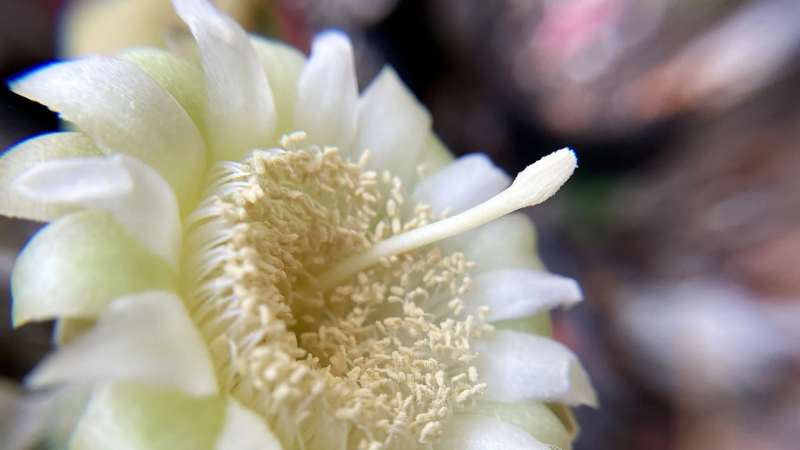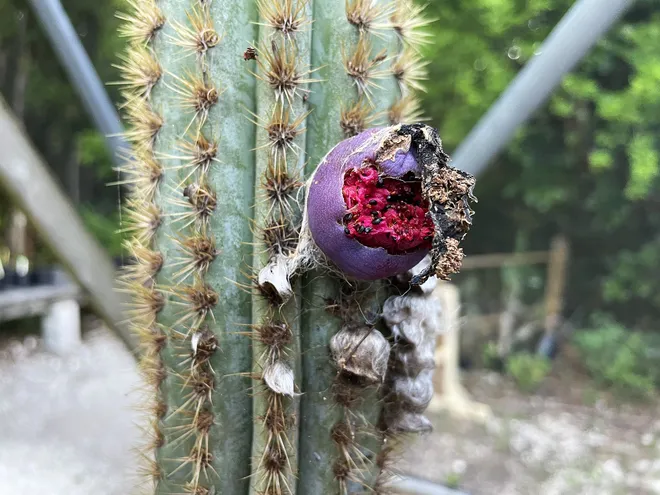A troubling first: Rising seas blamed for disappearance of rare cactus in Florida
A rare tree cactus that grew for decades hidden by a tangle of mangrove trees on Florida's Key Largo has lost its battle with rising sea levels and other pressures.
It's now considered locally extinct in the United States, a group of researchers reported in a study published this week. The demise of the cactus is believed to be the nation's first local extinction as a result of sea level rise, the study's authors say.
The cactus may be "a bellwether for how other low-lying coastal plants will respond to climate change,” said lead author Jennifer Possley, director of regional conservation at Fairchild Tropical Botanic Garden.
But thanks to heroic work by a partnership of plant protectors and researchers, hope endures that the tree cactus could one day be restored to the wild.
The stand of about 150 cactus stems was discovered in Key Largo on a low rocky outcropping in 1992. Its stems can rise more than 20 feet and produce fragrant flowers and bright red and purple fruit.
For years, researchers monitoring the plants thought they were the same species as another rare tree cactus growing elsewhere in the Keys. But tufts of long, wooly hairs growing at the base of its flowers and fruits ultimately convinced Alan Franck, a study co-author and herbarium manager at the Florida Museum of Natural History, that the trees were the first and only known U.S. occurrence of a species now known as Key Largo tree cactus.
The cactus cluster suddenly began to die over the past decade, under assault from saltwater intrusion, passing hurricanes, rising tides and predators, said James Lange, a co-author and one of Fairchild's research botanists. But the last remnants of the only known specimen of the tree cactus were rescued and taken to Fairchild's nursery and seed bank to prevent its total loss.

What does 'locally extinct' mean?
It means the cactus trees are no longer found in the Keys or South Florida, the researchers said. "Researchers know of no naturally growing Key Largo cacti in the United States," the study said.
Others still grow in a few locations in the Bahamas and Cuba. Those trees face the same threats as in Key Largo, said co-author George Gann, executive director of the Institute for Regional Conservation, a nonprofit that supports biodiversity research and ecological restoration of endangered habitats, primarily in South Florida.
In a few places, however, they do have something going for them that the Florida trees did not, Gann said. They’re growing at a higher elevation, which may give them some added protection.
Another word sometimes used is "extirpated," meaning a species has been wiped out in one geographical area even though it still exists in others, said Wesley Knapp, chief botanist at NatureServe, who confirmed the Key Largo location was the only one in the U.S.
“That’s unfortunately a pattern we’re going to see a lot more, these localized extirpations,” Knapp said. “These plants near sea level have nowhere to retreat to in many cases.”

Documenting a rapid demise
When Lange arrived with colleagues to check on the cactus plants in 2015, they discovered half the stems broken and parts of the plant chewed down to its fleshy tissues, he said.
The researchers had already noted an increase in saltwater flooding from higher-than-normal seasonal high tides in South Florida.
They surmised the high tides may have depleted freshwater resources and an animal might have been trying to get water from its stems, but they could never identify the culprit. Their camera trap caught raccoons, birds, rabbits and opossums on video but none actually eating the plant.
The following year, another half of the plants had died. At that point, the garden’s researchers and the Florida Department of Environmental Protection began taking a few cuttings to preserve them in greenhouses. It was becoming obvious the plant would not survive, so the question became how to save it and "help it recover and thrive," Lange said.
Then, Irma, a Category 5 hurricane, washed over the Keys, flooding large portions of Key Largo for days. The Fairchild team worked with several cactus populations in the Keys, collecting broken branches. Abnormally high tides arrived in 2019, again leaving large portions of the island flooded for more than three months.
How fast are sea levels rising in the Florida Keys?
Low-lying South Florida is especially vulnerable to the rising sea levels documented at federal tide gauges around the state. Sea level rise is driven by warmer temperatures that cause ocean water to expand and melt land-based glaciers and ice sheets, according to the National Oceanographic and Atmospheric Administration.
Record hot oceans:Experts surprised at super-charged Hurricane Beryl
NOAA reports the following in the Keys:
- On the northern end, sea level is rising 3.16 millimeters a year at Virginia Key.
- High-tide flood days on Virginia Key have more than doubled, with higher-than-normal flood days in 2015, 2016 and 2017.
- On Vaca Key, south of Key Largo, sea level rise averaged 4.21 millimeters a year since 1971, equivalent to a rise of 1.38 feet in 100 years.

Saving a rare species stem by stem
By 2021, only six remnant cactus stems remained alive on the mangrove-surrounded rocky outcropping.
"It was either step in to save the tree or it’s lost," Lange said. “We weren't sitting idly by watching this cactus die.”
They left the remaining few pieces of wild cactus to flower and fruit that year, then returned to salvage the remaining pieces.
Similar tools have been used for decades to save and reintroduce endangered animals and plants into the wild, Gann said. “This kind of work is happening all over the place and much more than people realize,” he said. “It’s a tool of last resort, but it’s a tool that we don't want to ignore when we're faced with the obvious.”
The fragmented stems are now among 60 specimens of the Key Largo tree cactus growing at Fairchild. Researchers have hand-pollinated its fragrant cream-colored flowers that attract bat pollinators in the wild, working to collect enough material to restore the plants to the wild one day.
They've also harvested more than 1,000 seeds, some of which are secured in the National Seed Bank in Fort Collins, Colorado.

Concerns for the future
“Ecosystems are changing, through both human and natural means, and that’s expected to increase,” Lange said.
Loss of habitat is the single-most important driver of biodiversity loss, and it’s likely other rare plants were lost before anyone was paying attention, Gann said. Unlike the cactus, some species native to the Florida Keys can’t be moved without affecting something else, he said, so there's going to be "some unavoidable loss."
In this case and others, he said, there's hope through the collaboration of groups working to save the tree cactus and other rare and endangered plants in the rapidly changing habitats of South Florida and the Florida Keys. The study's co-authors include the U.S. Forest Service, with part of the funding from the state's Department of Agriculture and Consumer services.
The problems demand collaboration and partnership, not competition, Gann said. “We know how to adapt and we have tools for taking plants out of the wild and into cultivation, so we can figure out what the restorative strategies are that we can deploy to stop losing biodiversity.”
Dinah Voyles Pulver covers climate and the environment for USA TODAY. Reach her at dpulver@gannett.com or @dinahvp.
Disclaimer: The copyright of this article belongs to the original author. Reposting this article is solely for the purpose of information dissemination and does not constitute any investment advice. If there is any infringement, please contact us immediately. We will make corrections or deletions as necessary. Thank you.


